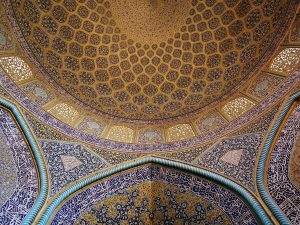Pamuk addresses the struggle of Eastern culture and art as they struggled to reconcile tradition with western influence. Because Islam condemns the practice of idolatry, the majority of Islamic art is centered upon scripture, geometric patterns and interlacing decorative designs known as arabesque (seen below).
This belief that all illustrations should be done from the perspective of Allah and not the artist himself seems to be in contradiction with the practice illuminated manuscripts that demands the artists’ discernment. We see such tensions being played out in the various passages such as “I am a Horse”. For the duration of the passage, the horse questions the sensibility behind his illustration–pointing out inconsistencies that are physically impossible such as both of his forelegs extending out at once. This is symbolic of people beginning to challenge the system and traditional way of thinking. Whats more, the fact that horse is instrumental in figuring out who the murderer is, makes me wonder to what extent can you enforce anonymity in a painting? Is it ever possible to really avoid all style and uniqueness on the part of the illustrator?


Eric,
I also found the Horse chapter of My Name is Red very telling. In fact, I’m planning on writing my essay with this chapter in mind.
As an artist, I think it is important to have the artist present in their work – if the artist is not there, how can they be showing us something new? Different perspectives is important not only to introduce new ideas to the work’s audience, but also to help the audience challenge their preconceived ideas.
Yet, I am torn. When I read the tree chapter from My Name is Red I can also understand the desire of illuminators to illuminate any sense of personal statement. Allah is all the matters, and anything that distracts, distracts from Allah’s power.
Maybe a way to reconcile is to look at illuminations and arabesques as something more aligned to prayer than to art – but I dislike this idea too because their work is beautiful and time consuming just like anyone else’s art. Ugh, it’s a toughy!
I guess this comment isn’t that helpful. I just wanted to express my shared interest in the Horse’s challenge of the traditional miniaturist practices.
Erica,
I think the idea of desiring to demonstrate a particular style and take credit for one’s work of art is a western mentality. Having been influenced by western culture my entire life, I also think that in order to exhibit new concepts and ideas to society and challenge widely accepted beliefs, there must be some type of connection between the artist and his/her work. However, after reading the novel it is clear that most of the characters think that the artist himself isn’t part of the take away: the art is. In the novel, though a couple of the artists working on the manuscript die, the work on the manuscript continues. This illustrates that the art does not need the artists in order to live on and share the teachings of Allah. Thus, it makes sense that avoiding all style and uniqueness on the part of the illustrators is a learned practice that reflects a culture of the East that we westerners are unfamiliar with.